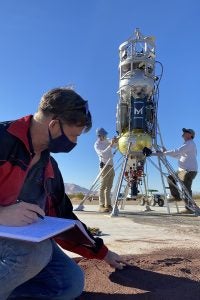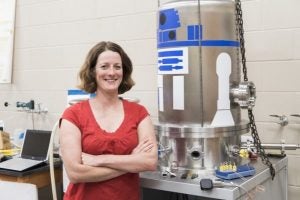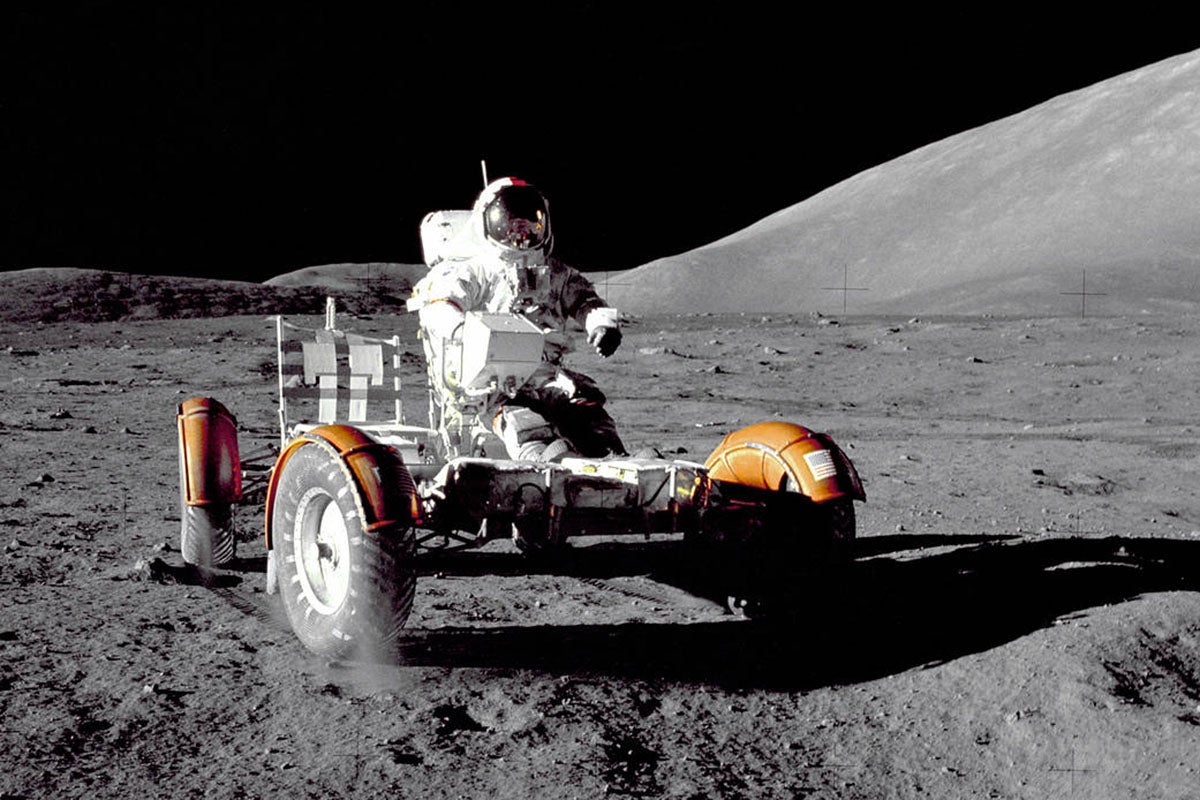A prototype sensor that detects Moon dust by shooting lasers through the sky has successfully completed its first hurdle. That means UCF is one step closer to building the real instrument that could fly to the moon on a future space mission.
UCF researchers designed the Ejecta STORM instrument to scan the area around a lunar lander for moondust and other hazards based on a concept planetary scientist Phil Metzger came up with about 10 years ago. Ejecta STORM stands for the Ejecta Sheet Tracking, Opacity and Regolith Maturity. NASA funded a proposal to study this instrument about a year ago. Earlier this month, a prototype that students helped build went onto a tethered rocket system for a few test flights, courtesy of the commercial partner Masten Space Systems, a space transportation company based in California.
Understanding how dust behaves on the moon and other planetary surfaces is critical for future space exploration missions. When a spacecraft lands or takes off, the dust it kicks off could damage engines, sandblast a nearby lunar outpost, or even impact a spacecraft orbiting the moon. There is also interest in knowing how dust on the lunar surface will behave when people are walking on it or rovers are driving around, says project co-investigator Adrienne Dove, a planetary scientist and assistant professor with UCF’s Department of Physics. The movement will likely generate a lot of complicated electrical and dynamical interactions.
That’s why NASA funded the Ejecta STORM project, through the Flight Opportunities program which allows researchers to use suborbital flights and other flight platforms to test and refine technology that may one day be used on missions to the moon and beyond.
https://youtu.be/u0sIH4UAikM
Test Flights
In the stillness of the Mojave Desert, Metzger watched as Masten Space Systems fired up its takeoff and vertical landing rocket, which mimics a lunar landing. Aboard the vehicle, UCF’s laser sensor, which was installed into the top of the rocket along with cameras. A bed of simulated lunar soil had been prepared underneath the rocket. During the flights the cameras collected video of the rocket exhaust blowing the dust across the laser beams.
“The tests went smoothly with four successful flights,” says Metzger. “We knew the tests were successful because we collected videos where the lasers could be clearly seen in each of the different colors of light so we can use those images to measure how much dust is in the clouds at each point along the lengths of the beams. We are now doing the post-test data processing on the videos to extract information about the dust and dynamics, proving the quality of data that can be collected during a lunar landing.”

Metzger, who is a researcher at UCF-based Florida Space Institute, is an expert on the moon and rocket plume interactions. He has several funded projects exploring a variety of topics related to the moon, including mining water from its surface.
The UCF team spent a year designing and building the prototype. Andrew O’Reilly, a third-year student studying electrical engineering, designed the electrical schematics — as well as the code for systems on the module, such as the laser function and cooling system.
“I think it’s amazing that I got the opportunity to work on this project and I know all the work everyone has put in will be worth it once we have a successful launch to space in the future,” O’Reilly says. “Not many students get to say they worked on a NASA mission.”
O’Reilly found a spot on the team because of his work in Dove’s lab. She specializes in dust dynamics of planetary systems and students work on a range of projects in her lab. Jillian Gloria, who majoring in aerospace engineering, is also working on the project. She is focused on the mounting and configuration options, as well as ways to optimize the physical system design and interfaces.
“While the effects of rocket plumes on surface regolith may not be the first thing that comes to mind when one thinks of traveling to the moon, it is one of the many that we must investigate and understand in order to successfully return for good,” Gloria says. “It has been an inspiration to work on this team, under the expert guidance and mentorship of Addie Dove and Phil Metzger, who have provided me the opportunity to develop skills and gain experience in an area for which I have a great deal of passion for. … If your passion is space, UCF is the place to be.”
Aidan St. John, who is studying mechanical engineering, designed the system that kept the video recording equipment in place for the test flight.
Mike Conroy, an instrument engineer based at the Florida Space Institute, rounds out the team. Before joining UCF, Conroy served as a NASA project manager at Kennedy Space Center. There he worked in the area of lunar and Martian exploration and simulation tools to support the new launch systems and a number of technology development efforts.
Conroy led the undergraduate students in construction of the prototype and performed pre-flight testing at UCF.
The team used simulated moon regolith (mock lunar dust) created at UCF’s Exolith laboratory in tests labs. The lab creates Mars, asteroid and Moon simulants for researchers to use in their studies.
Why Dust Matters
It may seem pretty basic, but scientists aren’t quite sure how the dust on the Moon works.
“The physics of how rocket exhaust blows lunar soil is extremely complicated and we are not yet able to write equations to predict or to simulate how much dust will be blown, how fast it will blow, and where it will go on the moon,” Metzger says. “We need to understand the physics so we can quantify the expected damage that might happen to a lunar basecamp during future lunar landings. Then, we will be able to design ways to mitigate the blowing dust to protect the outpost. But for now, we need to get high quality measurements of the physics during some actual lunar landings. Those measurements will enable us to calibrate our computer simulations to make better predictions of the physics.”
The Apollo missions show that the blowing dust can be extremely damaging. During Apollo 12, astronauts landed 160 meters away from the old Surveyor 3 spacecraft. The astronauts cut pieces off Surveyor 3 and brought them back to Earth. The pieces of hardware showed the landing of the Apollo 12 lunar module caused extreme pitting, chipping and scouring on the surfaces of Surveyor 3.

After some tweaking based on the performance in tests so far, the current Ejecta STORM prototype will be used for some additional tests with the Masten system. The next step for the UCF team is to build a higher fidelity prototype unit that has flight-like thermal controls and space-qualified electronics, Metzger says.
“Building that next generation prototype will allow us to do higher fidelity tests to prove the instrument is ready to fly to the moon,” Metzger says. “We are currently seeking funding to do that last level of development.”
Dove has a bachelor’s degree from the University of Missouri and a doctoral degree from the University of Colorado. She’s been teaching and conducting research at UCF since 2012. She has published articles and presented at dozens of conferences around the world and is an award- winning physicist. She is often quoted in the press for her expertise and is a co-host of Walkabout the Galaxy podcast.
Before joining UCF, Metzger worked at NASA’s Kennedy Space Center from 1985 to 2014. He earned both his master’s (2000) and doctoral (2005) degrees in physics from UCF. He’s published dozens of papers and is regularly quoted in the press for his expertise on planetary topics.




